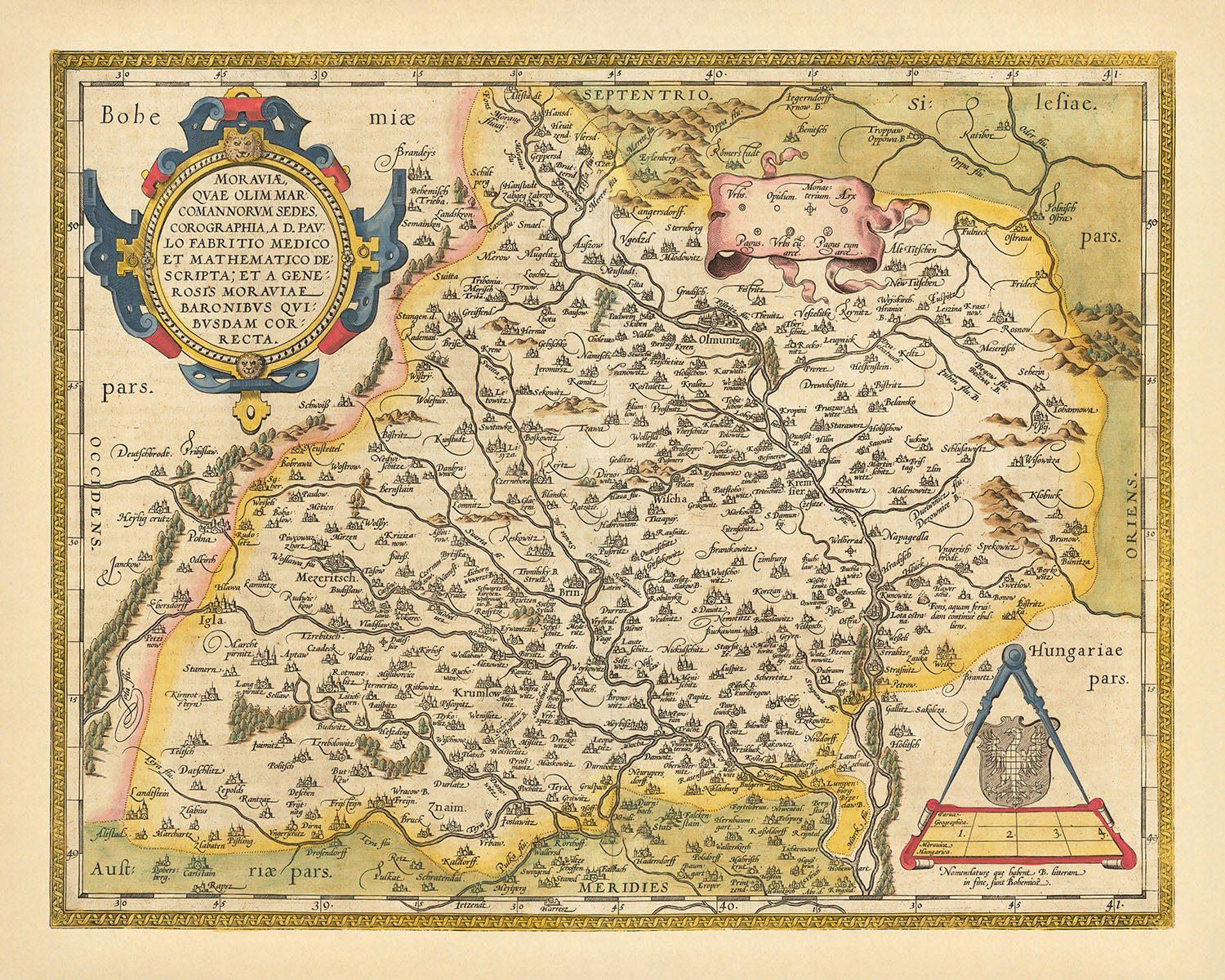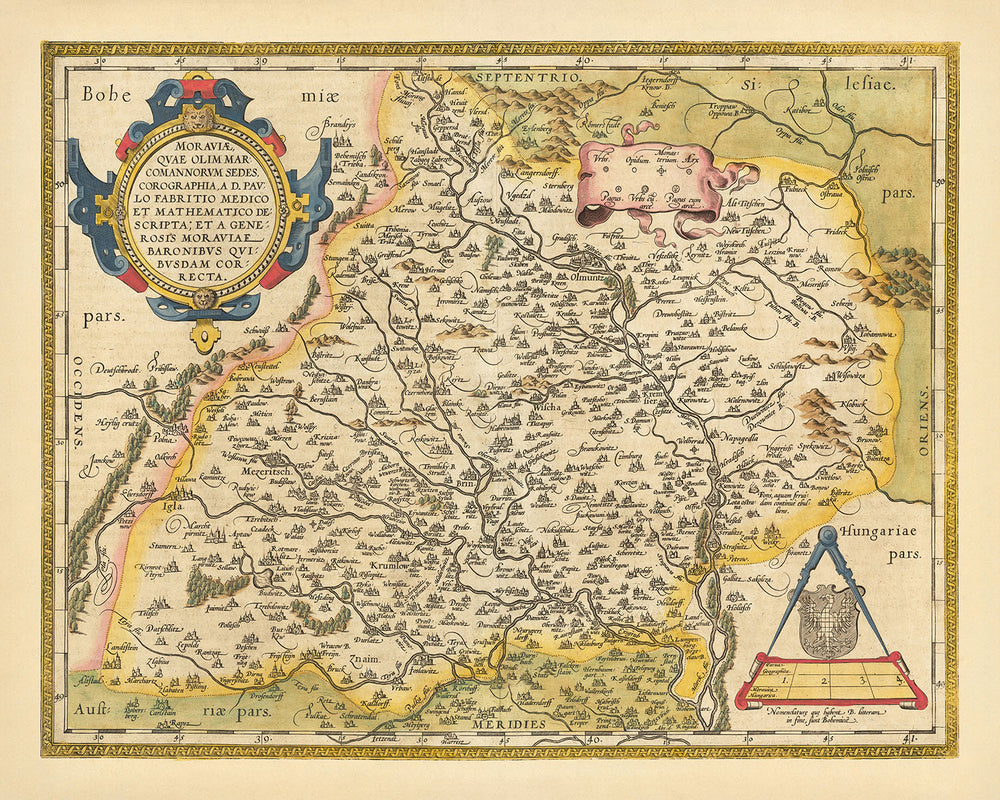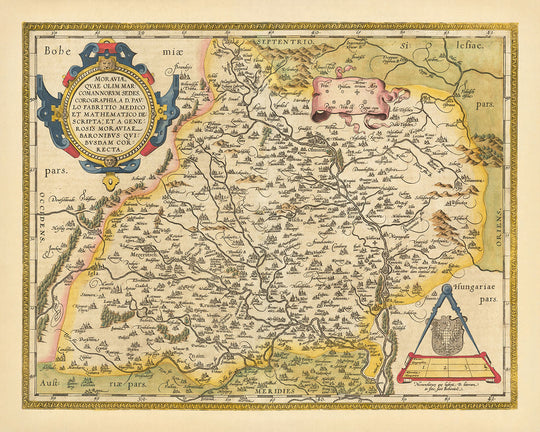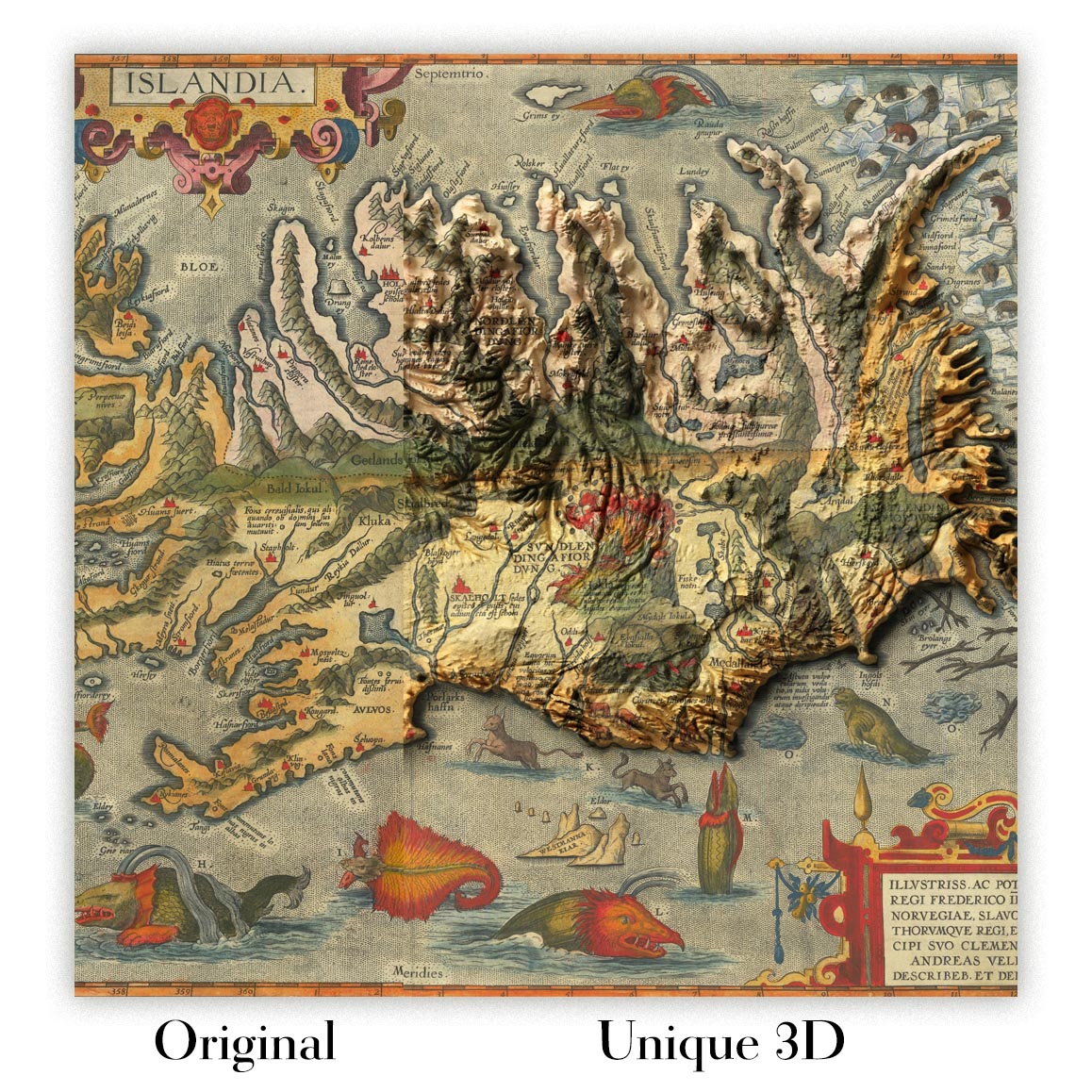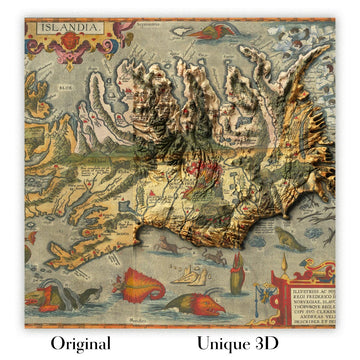- Handmade locally. No import duty or tax
- FREE Delivery by Christmas
- Love it or your money back (90 days)
- Questions? WhatsApp me any time
Own a piece of history
5,000+ 5 star reviews


The "Moraviae, Quae Olim Marcomannorum Sedes Corographia" is a captivating cartographic masterpiece created by the esteemed Flemish cartographer Abraham Ortelius in 1608. This map, part of Ortelius' groundbreaking "Theatrum Orbis Terrarum," the first modern atlas of the world, is a testament to the rich history and geographical intricacies of the Moravian region. Ortelius, renowned for his meticulous attention to detail and artistic flair, has masterfully depicted the political and physical landscape of Moravia, showcasing fortified cities, towns, and natural features with remarkable precision and elegance.
Ortelius' map is adorned with a large strapwork cartouche, an ornate title banner, and a smaller cartouche, all of which exemplify the decorative style of early 17th-century cartography. The fine old coloring enhances the visual appeal, making the map not only a valuable historical document but also a piece of art. The decorative elements, including mythical sea creatures and ships, add a touch of whimsy and intrigue, inviting viewers to explore the map's many facets. The compass rose and scale bar, embellished with artistic details, further demonstrate Ortelius' dedication to both form and function.
The map provides a detailed view of Moravia, a historical region now part of the Czech Republic, and its surrounding areas, including parts of Bohemia, Austria, Silesia, and Hungary. It meticulously charts the region's rivers, mountain ranges, and forested areas, offering insights into the natural landscape that shaped the lives of its inhabitants. The representation of major rivers and topographical features, such as valleys and plains, highlights the geographical diversity and strategic importance of Moravia in Central Europe.
Ortelius' depiction of fortified cities and towns is particularly noteworthy, as it reflects the political and military landscape of the time. Cities such as Brno, Olomouc, and Znojmo are prominently featured, along with numerous smaller towns and settlements. The map's detailed portrayal of roads and pathways connecting these urban centers underscores the region's role as a hub of trade and communication. The inclusion of historical coats of arms and heraldic symbols adds an additional layer of historical context, linking the map to the noble families and political entities that shaped Moravia's history.
The historical significance of this map extends beyond its geographical content. As part of Ortelius' "Theatrum Orbis Terrarum," it represents a major milestone in the history of cartography, marking the transition from medieval map-making traditions to modern techniques. The map's detailed and accurate representation of Moravia provides valuable insights into the region's history, culture, and geography during the early 17th century. Collectors and historians alike will appreciate the map's artistic beauty, historical importance, and the glimpse it offers into the world as it was understood by one of history's greatest cartographers.
Cities and towns on this map
- Brno (Brünn)
- Olomouc (Olmütz)
- Znojmo (Znaim)
- Jihlava (Iglau)
- Kroměříž (Kremsier)
- Uherské Hradiště (Ungarisch Hradisch)
- Šumperk (Mährisch Schönberg)
- Prostějov (Proßnitz)
- Vyškov (Wischau)
- Vsetín (Wsetin)
- Hodonín (Göding)
- Břeclav (Lundenburg)
- Blansko (Blanz)
- Boskovice (Boskovitz)
- Kyjov (Gaya)
- Mikulov (Nikolsburg)
- Třebíč (Trebitsch)
- Litovel (Littau)
- Zábřeh (Hohenstadt)
- Hranice (Mährisch Weißkirchen)
Notable Features & Landmarks
- Large strapwork cartouche with the map title.
- Title banner with ornate design.
- Smaller cartouche with additional information.
- Rivers and water bodies, including major rivers flowing through Moravia.
- Mountain ranges depicted with hachures.
- Forested areas indicated with tree symbols.
- Decorative compass rose.
- Scale bar with a decorative compass.
- Borders of adjacent regions: Bohemia, Austria, Silesia, Hungary.
- Fortified cities marked with distinctive symbols.
- Major roads and pathways connecting cities and towns.
- Historical coats of arms and heraldic symbols.
- Artistic representation of the Marcomanni tribe's historical seat.
- Topographical features, such as valleys and plains.
- Decorative elements, including mythical sea creatures and ships in surrounding waters.
- Artistic embellishments around the map's border.
Historical and design context
- Name of the map: Moraviae, Quae Olim Marcomannorum Sedes Corographia
- Date of creation: 1608
- Mapmaker/Publisher: Abraham Ortelius
- Context about the mapmaker: Ortelius was a Flemish cartographer and geographer, recognized for creating the first modern atlas, "Theatrum Orbis Terrarum," which was first published in 1570.
- Topics and themes:
- Political and physical geography: The map details the political boundaries, fortified cities, towns, and physical features such as rivers and mountains.
- Historical context: The map represents Moravia, a historical region in Central Europe, which was once the seat of the Marcomanni tribe.
- Countries and regions shown:
- Moravia (historical region, now part of the Czech Republic)
- Parts of Bohemia, Austria, Silesia, and Hungary
- Design and style:
- The map is designed with a decorative strapwork cartouche and ornate title banner.
- It employs fine old coloring techniques typical of maps from the early 17th century.
- Historical significance:
- The map is significant as part of Ortelius' "Theatrum Orbis Terrarum," marking a major development in the history of cartography.
- It provides insights into the geographical understanding and political boundaries of Central Europe in the early 17th century.
Please double check the images to make sure that a specific town or place is shown on this map. You can also get in touch and ask us to check the map for you.
This map looks great at every size, but I always recommend going for a larger size if you have space. That way you can easily make out all of the details.
This map looks amazing at sizes all the way up to 70in (180cm). If you are looking for a larger map, please get in touch.
The model in the listing images is holding the 16x20in (40x50cm) version of this map.
The fifth listing image shows an example of my map personalisation service.
If you’re looking for something slightly different, check out my collection of the best old maps to see if something else catches your eye.
Please contact me to check if a certain location, landmark or feature is shown on this map.
This would make a wonderful birthday, Christmas, Father's Day, work leaving, anniversary or housewarming gift for someone from the areas covered by this map.
This map is available as a giclée print on acid free archival matte paper, or you can buy it framed. The frame is a nice, simple black frame that suits most aesthetics. Please get in touch if you'd like a different frame colour or material. My frames are glazed with super-clear museum-grade acrylic (perspex/acrylite), which is significantly less reflective than glass, safer, and will always arrive in perfect condition.
This map is also available as a float framed canvas, sometimes known as a shadow gap framed canvas or canvas floater. The map is printed on artist's cotton canvas and then stretched over a handmade box frame. We then "float" the canvas inside a wooden frame, which is available in a range of colours (black, dark brown, oak, antique gold and white). This is a wonderful way to present a map without glazing in front. See some examples of float framed canvas maps and explore the differences between my different finishes.
For something truly unique, this map is also available in "Unique 3D", our trademarked process that dramatically transforms the map so that it has a wonderful sense of depth. We combine the original map with detailed topography and elevation data, so that mountains and the terrain really "pop". For more info and examples of 3D maps, check my Unique 3D page.
For most orders, delivery time is about 3 working days. Personalised and customised products take longer, as I have to do the personalisation and send it to you for approval, which usually takes 1 or 2 days.
Please note that very large framed orders usually take longer to make and deliver.
If you need your order to arrive by a certain date, please contact me before you order so that we can find the best way of making sure you get your order in time.
I print and frame maps and artwork in 23 countries around the world. This means your order will be made locally, which cuts down on delivery time and ensures that it won't be damaged during delivery. You'll never pay customs or import duty, and we'll put less CO2 into the air.
All of my maps and art prints are well packaged and sent in a rugged tube if unframed, or surrounded by foam if framed.
I try to send out all orders within 1 or 2 days of receiving your order, though some products (like face masks, mugs and tote bags) can take longer to make.
If you select Express Delivery at checkout your order we will prioritise your order and send it out by 1-day courier (Fedex, DHL, UPS, Parcelforce).
Next Day delivery is also available in some countries (US, UK, Singapore, UAE) but please try to order early in the day so that we can get it sent out on time.
My standard frame is a gallery style black ash hardwood frame. It is simple and quite modern looking. My standard frame is around 20mm (0.8in) wide.
I use super-clear acrylic (perspex/acrylite) for the frame glass. It's lighter and safer than glass - and it looks better, as the reflectivity is lower.
Six standard frame colours are available for free (black, dark brown, dark grey, oak, white and antique gold). Custom framing and mounting/matting is available if you're looking for something else.
Most maps, art and illustrations are also available as a framed canvas. We use matte (not shiny) cotton canvas, stretch it over a sustainably sourced box wood frame, and then 'float' the piece within a wood frame. The end result is quite beautiful, and there's no glazing to get in the way.
All frames are provided "ready to hang", with either a string or brackets on the back. Very large frames will have heavy duty hanging plates and/or a mounting baton. If you have any questions, please get in touch.
See some examples of my framed maps and framed canvas maps.
Alternatively, I can also supply old maps and artwork on canvas, foam board, cotton rag and other materials.
If you want to frame your map or artwork yourself, please read my size guide first.
My maps are extremely high quality reproductions of original maps.
I source original, rare maps from libraries, auction houses and private collections around the world, restore them at my London workshop, and then use specialist giclée inks and printers to create beautiful maps that look even better than the original.
My maps are printed on acid-free archival matte (not glossy) paper that feels very high quality and almost like card. In technical terms the paper weight/thickness is 10mil/200gsm. It's perfect for framing.
I print with Epson ultrachrome giclée UV fade resistant pigment inks - some of the best inks you can find.
I can also make maps on canvas, cotton rag and other exotic materials.
Learn more about The Unique Maps Co.
Map personalisation
If you're looking for the perfect anniversary or housewarming gift, I can personalise your map to make it truly unique. For example, I can add a short message, or highlight an important location, or add your family's coat of arms.
The options are almost infinite. Please see my map personalisation page for some wonderful examples of what's possible.
To order a personalised map, select "personalise your map" before adding it to your basket.
Get in touch if you're looking for more complex customisations and personalisations.
Map ageing
I have been asked hundreds of times over the years by customers if they could buy a map that looks even older.
Well, now you can, by selecting Aged before you add a map to your basket.
All the product photos you see on this page show the map in its Original form. This is what the map looks like today.
If you select Aged, I will age your map by hand, using a special and unique process developed through years of studying old maps, talking to researchers to understand the chemistry of aging paper, and of course... lots of practice!
If you're unsure, stick to the Original colour of the map. If you want something a bit darker and older looking, go for Aged.
If you are not happy with your order for any reason, contact me and I'll get it fixed ASAP, free of charge. Please see my returns and refund policy for more information.
I am very confident you will like your restored map or art print. I have been doing this since 1984. I'm a 5-star Etsy seller. I have sold tens of thousands of maps and art prints and have over 5,000 real 5-star reviews. My work has been featured in interior design magazines, on the BBC, and on the walls of dozens of 5-star hotels.
I use a unique process to restore maps and artwork that is massively time consuming and labour intensive. Hunting down the original maps and illustrations can take months. I use state of the art and eye-wateringly expensive technology to scan and restore them. As a result, I guarantee my maps and art prints are a cut above the rest. I stand by my products and will always make sure you're 100% happy with what you receive.
Almost all of my maps and art prints look amazing at large sizes (200cm, 6.5ft+) and I can frame and deliver them to you as well, via special oversized courier. Contact me to discuss your specific needs.
Or try searching for something!







